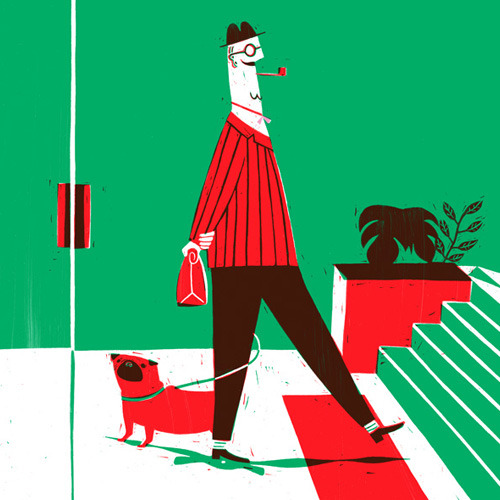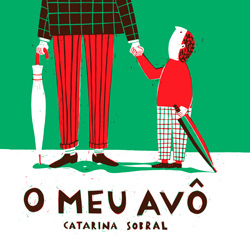< Back to posts
Catarina Sobral
Portugal

Catarina Sobral is a Portuguese illustrator, animator and graphic designer. She's the creator of three award-winning picturebooks which are published by Orfeu Negro and translated into many languages. In 2014, Catarina won the 5th International Award for Illustration at the Bologna Children’s Book Fair.
In this post, Catarina talks about ‘O Meu Avô’ (My Grandad). The jury of the 5th International Award for Illustration at the Bologna Children’s Book Fair agreed that this work shows a great maturity, a strong personal identity, a clear control of composition, and profound sentiment shown through pure lines and primary colours.
Catarina: At a certain point in ‘The Notebooks of Malte Laurids Brigge’, Malte begins telling the story of a neighbour who decided to trade all the years of life that he still had for days, hours, minutes and, “if you could bear it,” for seconds. As the days went by, however, he realised that no matter how much time he tried to save, there was none left. And that, contrary to what happens with a year, this “infernal pocket change” just kept disappearing – God knows how. He felt he'd acted too hastily and wanted to get his time back... in 10-year notes, four of them, and one 5-year note; as for the rest, the bank could have it!
This chapter made me want to write a story about time, more specifically about how we spend our lives running around and wasting precious minutes and seconds. Since I wanted to tell this story primarily through images, I thought about juxtaposing two characters (the neighbours, like in ‘The Notebooks’) and allowing the written text to narrate the routine of only one of them. This way, I'd be able to play with the relationship between text and image, between adjoining pages, and with the montage of the book.
At the same time, I wanted to make a book which was narrated by a child (in my books, the characters are mostly adults). This is when the grandfather (heavily inspired by Monsieur Hulot) and the grandson narrator appeared. The neighbour would obviously have to be someone younger, with an experience of the passage of time and of the rhythm of daily life – opposite to that of a dandy grandfather who writes love letters and has picnics on the grass. I named him Dr Sebastian (he's a kind of alter ego) and he is introduced like this: “My grandfather used to have a clock store. Now he has plenty of time. Dr Sebastian is not a watchmaker (although he is always looking at the clock) and he never has any time to lose.”
Once the characters were defined, I moved on to the structure of the book: three double pages at the start where the characters are introduced, and three double pages at the end where the narrative is concluded. In between, all illustrations are single pages, with the grandfather on the important page (on the right). On the first two spreads and on the last one, the grandfather is on the left page, and only crosses the spine of the book when the text says, in effect, that the two characters usually cross paths in the morning and at night. The book doesn't tell the story of a single day, but it felt like a good measure of time to use the start and the end of the day to start and end the book, giving the grandson's words some circularity.
In many of the pages in the middle, I tried to find symmetries or similar compositions, positions or points of view, in order to reiterate the idea of juxtaposition. All the day-to-day activities that are described work in parallel and, at the same time, in opposition. For example, when the grandson says that his grandfather often travels to Paris, we see him sitting on an armchair, wearing a beret and looking at photos from when he was in Paris in 1962. It is metaphoric travel, and the image amplifies the meaning of the text. On the contrary, and furthering the text (which was purposely positioned on Dr Sebastian's page), the grandfather's neighbour is actually in Paris, astoundingly, on work. Like Monsieur Hulot in ‘Playtime’, who can never see the Paris of the Eiffel Tower and of the Sacré-Cœur, except in mirrors and reflections. But this is not the only reference.
My books talk with each other and with other works of art, and I like to introduce intertextuality in my books. There are also references to Manet's ‘Le déjeuner sur l'herbe’, to Chaplin's ‘Modern Times’, to Fernando Pessoa, to Almada Negreiros, and to ‘Groundhog Day’ (Dr Sebastian is a sort of Bill Murray, waking up each day on the very same day, with a Panasonic alarm clock).
The storyboard and the text were practically entirely defined before I began the illustrations, although several pages in the middle changed position after the illustrations were created, for the sake of rhythm. I wanted the illustrations to have a graphic tone that referenced the past (because we are talking about a grandfather and because of my own references), so I decided to do the book in spot colours, with overprint, and with a more geometric language. That is when I tried the following technique: overlapping acetates painted with acrylic paint, which is scraped with a box cutter, using the same principle as in linocut or woodcut printing.
I tried to use a contemporary language with the technique, printing and method of representation, even though I was referencing a different time. Of course, this was not a quick discovery; it never is. It always requires a lot of work before I get two or three images that look right for the tone I want for the book. But once those images are done, the process is a lot faster. Since I was going to use spot colours in overprint, I had to select two colours with high contrast. The colour that I use most frequently (other than black) is red, and red's complementary colour is green. Yellow and pink were more arbitrary options. Since the acetate layers would have to be prepared digitally as layers on black, I used black acrylic paint. I also did this so that I could get greater contrast for scanning. Because of this, the book's original sheets are a kind of photolithograph, where black is information that is turned into colour during offset printing.
The cover was designed to present the three main characters (grandfather and grandson on the front, Dr Sebastian on the back cover) and to create greater identification between the reader and the grandson (we only see the grandfather's face on the inner pages of the book. On the cover and title page, he's either cropped or with his back towards us).
Since my grandfather died young, I have the same physical memory of him as a child's: someone very strong, very tall, a great man. And the grandfather on the cover could be any reader's grandfather, even mine, who never wore a suit and caught rain with his shoulders. I hardly used any shadows in this book, but on the cover and the third double-page spread I decided to create an almost imperceptible visual metaphor: the shadow projected by the grandfather is shaped like the two hands of a clock.
The book's closing sentence was decided after all the illustrations were created (including the one on the final page). Contrary to what seems to be said throughout the book (it is the grandfather who has a lot of time, not Dr Sebastian), the grandson ends the story saying: “Time flies when I'm with my grandfather.” After all, no matter how much time we have, the way we experience it is subjective: it always goes by too quickly when we are doing what we like. And it flies by in the company of those we love.
Illustrations © Catarina Sobral. Post translated by Gengo and edited by dPICTUS.
O Meu Avô / My Grandad
Catarina Sobral
Orfeu Negro, Portugal, 2014
My Grandad and Dr Sebastian. Two characters, two different times. My Grandad used to have a clock shop. Now he has a lot of free time. He takes Pilates classes, learns German and writes love letters for hours on end. Dr Sebastian isn't a watchmaker, but he never wastes a minute... This is a small format book on modern times, sprinkled generously with artistic references from Jacques Tati to Fernando Pessoa, the Portuguese poet.
- Portuguese: Orfeu Negro
- Portuguese (Brazil): WMF Martins Fontes
- French: Hélium
- Italian: La Nuova Frontiera
- Swedish: Urax Förlag
- Korean: Neungyule Education

















